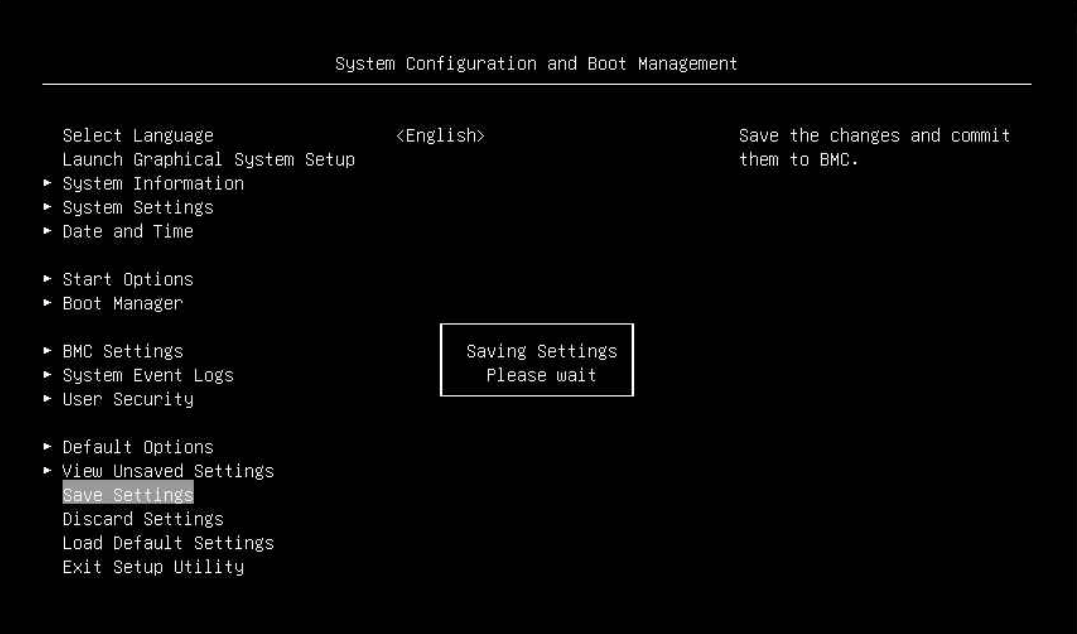Author
Published
21 Mar 2025Form Number
LP2184PDF size
24 pages, 2.5 MBAbstract
Today’s IT industry mega trend poses several challenges and requirements to the next generation of server interconnect technology. These challenges include faster data movement and processing, increased memory capacity and bandwidth, heterogeneous computing, and server disaggregation.
CXL is an open standard industry-supported cache-coherent interconnect technology for processors, memory expansion, and accelerators, that is designed to meet the IT industry mega trend requirements.
Essentially, CXL technology maintains memory coherency between the CPU memory space and memory on attached devices. It leverages existing PCIe Gen 5 bus and implements the required features such as cache-coherency, low latency and high bandwidth. This enables resource sharing or pooling for higher performance, reduces software stack complexity, and lowers overall system cost.
Lenovo has implemented the CXL technology in ThinkSystem V4 servers, answering the IT industry needs for high performance computation workloads in AI, ML, HPC, and Communication industries.
Introduction
In this section, we introduce the support for CXL technology in Lenovo ThinkSystem V4 servers, which includes three types of devices and three types of protocols. This white paper focuses on the support for CXL memory devices in Lenovo V4 servers, with a detailed discussion on CXL memory devices provided in the next section.
CXL is an alternate set of protocols that run across the standard PCIe physical layer that can auto-negotiate to either the standard PCIe transaction protocol or the alternate CXL transaction protocols, as shown in Figure 1. It is a high-performance I/O bus architecture used to interconnect peripheral devices, either traditional non-coherent IO devices or accelerators with additional capabilities.
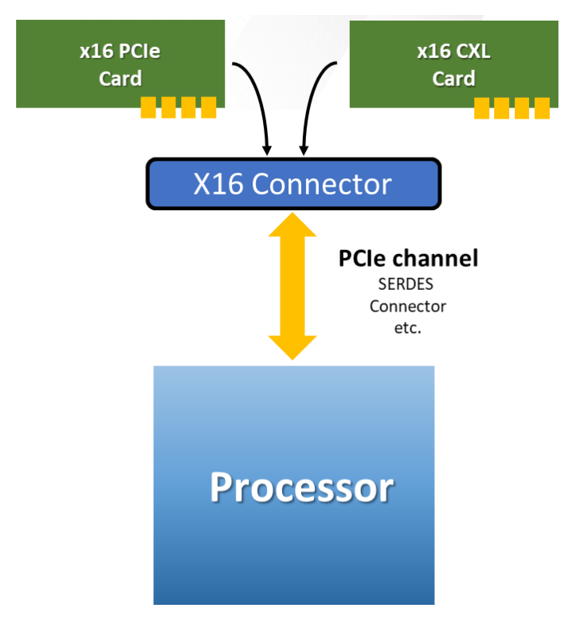
Figure 1. CXL runs on the standard PCIe physical layer but with CXL transaction protocols
CXL currently supports three types of devices, including type 1 caching devices, type2 accelerators with memory, and type 3 memory buffers (devices and modules), as showed in Figure 2. This white paper focuses on the type 3 memory devices.
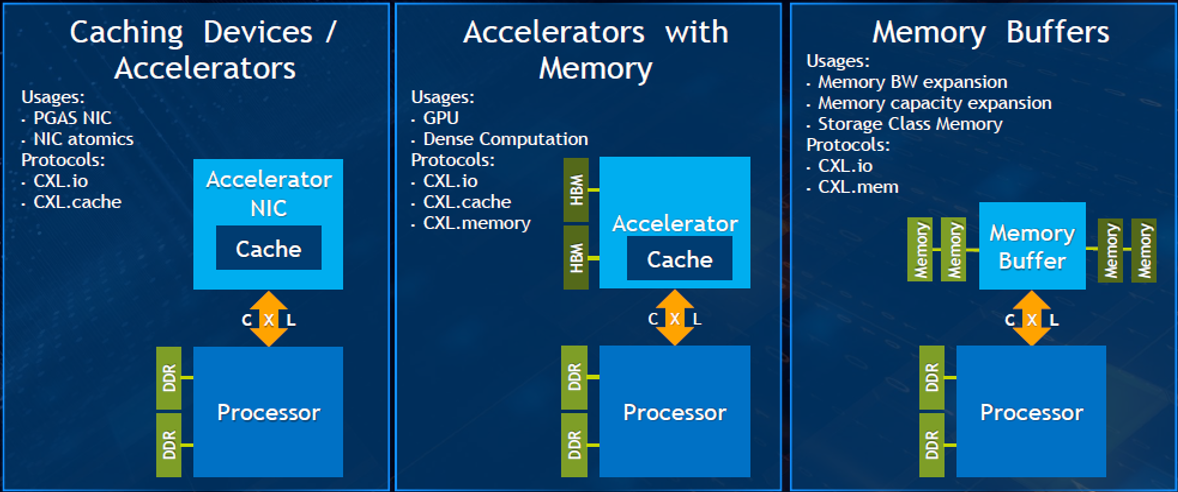
Figure 2. CXL supports three types of devices and three types of protocols
The three types of devices depend on the use cases and the transaction layers needed. These transaction layers are CXL.io, CXL.cache, and CXL.mem.
- The CXL.io is mandatory in all the CXL device types. It provides a non-coherent load/store interface for I/O devices. The CXL.io is not used for CXL.mem or CXL.cache protocol. For example, CXL.io is used for credit-based flow control, which is not used for CXL.cache or CXL.mem.
CXL.io is always required for discovery and enumeration, error reporting, and Host-Managed Device Memory (HDM). CXL.io can also be used for transaction types, transaction packet formatting, credit-based flow control, virtual channel management and transaction ordering rules that follow the PCIe definition.
- CXL.cache protocol defines the interactions between the device and hosts as some requests. This is applied when use cases have special needs that make a fully coherent cache in the device valuable. Essential coherency allows an accelerator to implement any ordering mode and enables it to implement unlimited atomic operations.
- CXL.mem is the CXL Memory protocol, a transactional interface between the CPU and memory. It applies to different memory types (volatile, persistent, among others) and configurations (flat and hierarchical). This protocol supports various attach options, highlighting when the Memory Controller (MC) is in the Host CPU, when the MC is within an accelerator device, or when the MC is in the memory buffer chip.
CXL memory device support
In this section, we first discuss the architecture of the Lenovo ThinkSystem V4 servers from CXL memory device support perspective and then discuss this support from both hardware and software views from the Linux OS perspective.
CXL device support introduction
From the platform perspective, when a CXL device is attached to a CXL-capable PCIe bus, this PCIe bus will be switched to the Flex bus protocol by system firmware and runs the CXL.io, CXL.cache and/or CXL.mem protocols on top of Flex bus, as shown in Figure 3.
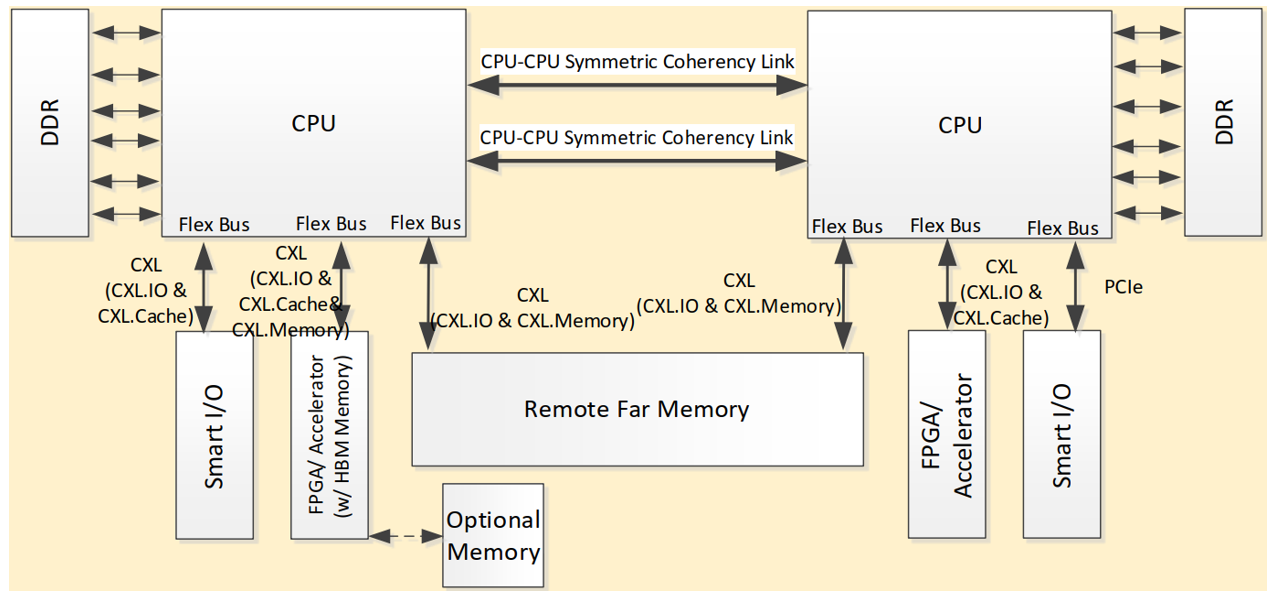
Figure 3. PCIe bus switches to Flex bus and runs the CXL.io, CXL.cache, and CXL.mem protocols
CXL device support: Hardware perspective
The right side of Figure 4 is the internal block diagram of a specific CXL memory device (memory expander). As can be seen in the block diagram of a CXL memory device, there is a CXL controller that is in charge of handling CXL protocols and data transactions.

Figure 4. CXL memory device block diagram
There are several form factor implementations of CXL memory devices, as shown in Figure 5.
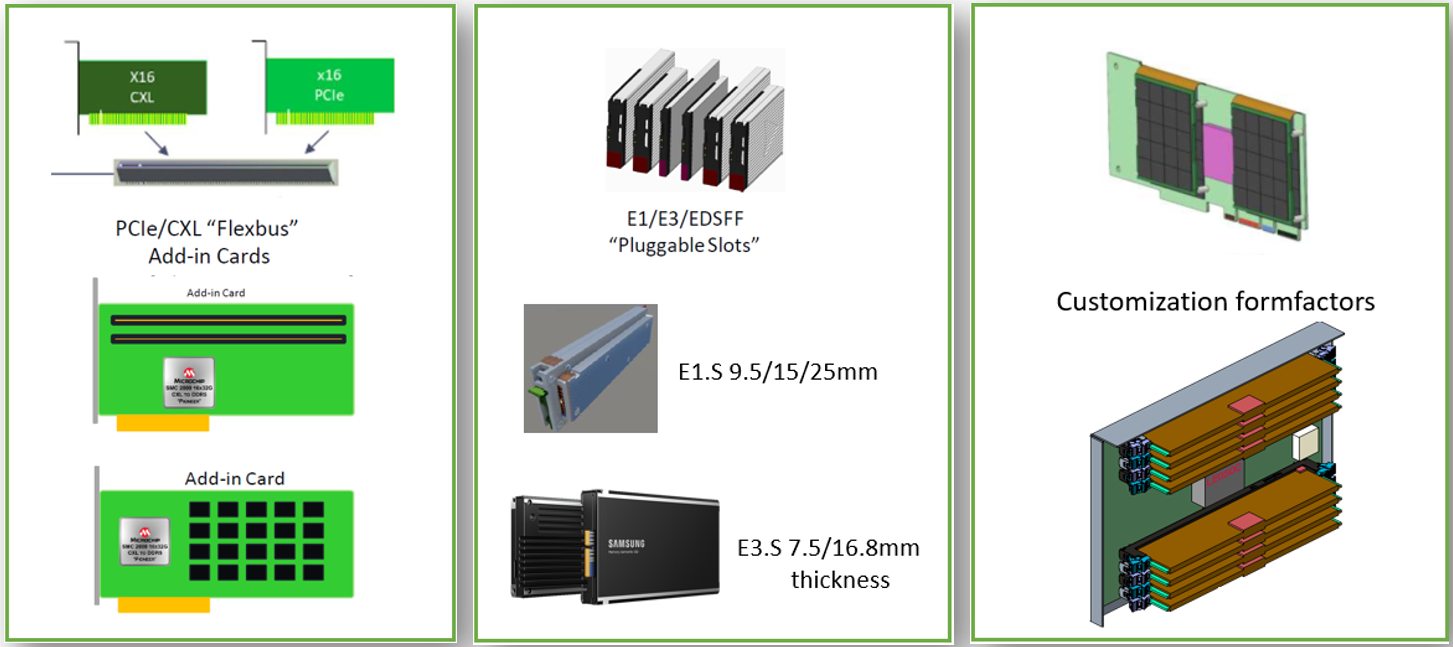
Figure 5. Several CXL memory device form factor implementations
In this paper, we will install and validate E3.S CXL memory modules in the Lenovo ThinkSystem SR630 V4 server (as shown in Figure 6) with Ubuntu 24.04 LTS server version OS installed. For the details of setup and validation, see the “Enabling CXL on the ThinkSystem servers” and “CXL Memory Module Validation” sections in this white paper.

Figure 6. Lenovo ThinkSystem SR630 V4
The benefits with the CXL memory devices installed in the server system include:
- Increased Memory Capacity — Improve processor performance, faster execution and/or run more VMs/processes.
- Increased Memory Bandwidth — For machine learning or other workloads needing higher memory bandwidths.
- Memory Pooling — Allows for optimal provision of local DRAM on server motherboard.
CXL device support: Software perspective
In this section, we will focus on the CXL memory device support from the server system firmware (UEFI) and the Linux OS perspective.
In its most basic form, the system software component responsibilities are:
- The system firmware is responsible for enumerating and configuring volatile CXL memory capacity that is present at boot time.
- The Linux OS components are responsible for enumerating and configuring all topologies not covered by the system firmware.
For the CXL memory devices to be supported on the servers, the server system firmware will need to implement the Advanced Configuration and Power Interface (ACPI) standard that allows the CXL devices to be discovered and interact with the Linux OS. Major CXL-related ACPI tables and data structures and their functions are summarized in Table 1.
For the Linux OS CXL support, CXL for memory devices utilizes the existing Linux NVDIMM architecture, replacing the NVDIMM Firmware Interface Table (NFIT) based interfaces with ACPI0017 CEDT based CXL interfaces, and adding a CXL subsystem to handle the new CXL specific functionality.
OS CXL components are introduced that utilize the information provided through the ACPI0017 CEDT in the OS layer and the ACPI0016 in the firmware layer. The Linux OS CXL components and their functions are summarized in Table 2 and Figure 7.
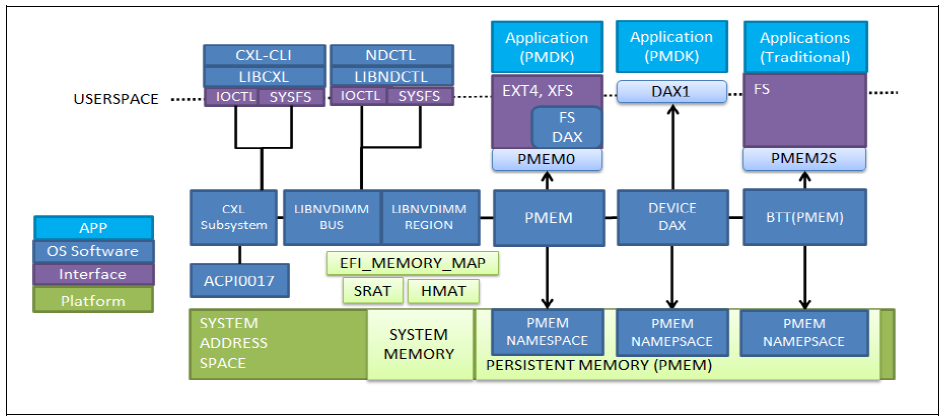
Figure 7. Linux CXL Architecture Diagram
For the CXL memory devices operation modes, an Intel processor attached with CXL memory expansion devices can support three types of CXL-attached memory operation modes: 1LM+Vol mode (One-Level Memory + Volatile mode, also referred to as memory tiering), Heterogeneous interleave mode, and Intel Flat Memory mode.
- 1LM+Vol mode
1LM+Vol or memory tiering is the default memory mode and allows capacity expansion. This 2-tier memory mode implies the native DDR5 and CXL attached memory are different address spaces and separate NUMA nodes.
This mode is also referred to as Software Managed tiering considering a software entity must manage the placement of data in separate tiers and must manage any desired movement of data between tiers. This management of placement and movement may be performed by the OS, or by a higher-level middleware or directly by an application.
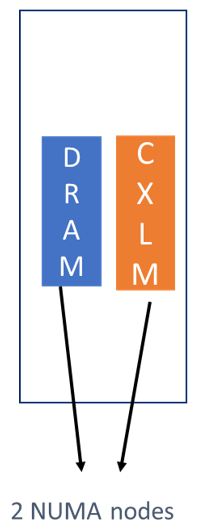
Figure 8. CXL memory device configured to run in the 1LM+Vol mode - Heterogeneous Interleave mode
This mode supports memory interleave between CXL memory attached device and native DDR memory. Interleaving of memory requests across a combination of native attach DDR5 channels and CXL-connected memory to increase aggregate bandwidth.
The entire combined capacity of native DDR memory and CXL is visible to the software as a single NUMA domain. As a result, no software changes are needed in the system to use the Heterogeneous Interleave mode.

Figure 9. CXL memory device configured to run in the Heterogeneous Interleave mode - Intel Flat Memory mode
Intel Flat Memory mode uses logic in the processor to keep frequently used data in DRAM where performance is best and swapping out less frequently used data to CXL memory. The movement of data between two memory tiers is completely managed at the hardware level without any OS intervention.
The CPU itself creates a single NUMA node and memory tier exposed to the OS, combining DRAM and CXL-attached memory in a 1:1 capacity ratio. Data is moved between DRAM and CXL memory at a cache line granularity. The memory controller will keep those cache lines accessed frequently in DRAM, and those cache lines that are not accessed frequently will be residing in CXL-attached memory. This process is completely transparent to the software.
This feature eliminates the need for any OS or application-level software changes to augment server memory resources via CXL.
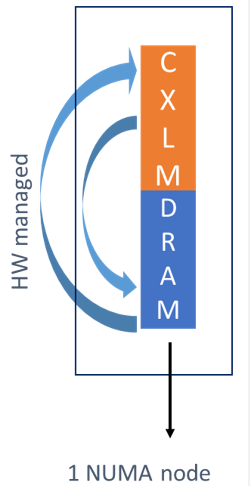
Figure 10. CXL memory device configured to run in the Intel Flat Memory mode
Note that not every memory population of the DRAM and CXL-attached memory combination supports all three CXL memory operation modes. For the specific CXL mode that is planned to run on a system, please check the server system specification for the required population rules and the required DRAM and CXL memory module specifications (such as memory frequency and capacity) for that system before the deployment.
In case you set the CXL memory modules to either Heterogenous Interleave mode or Intel Flat Memory mode but the installed DRAM and CXL memory modules do not meet the required specifications, the system firmware will disable these two modes and the CXL memory modules will fall back to 1LM+Vol mode.
Note: ThinkSystem SR630 V4 currently does not support Intel Flat Memory mode, as shown in Figure 12.
Enabling CXL memory
In this section, we will demonstrate how the CXL memory devices can be used with Lenovo ThinkSystem SR630 V4 server. As there will be only one NUMA node per CPU when the CXL memory devices are configured to run in either Heterogeneous Interleave mode or Intel Flat Memory mode (this mode is not supported by Lenovo V4 servers yet), we will focus on the setup of 1LM+Vol CXL memory mode which will have two NUMA nodes per CPU seen in the OS when correctly configured.
The configuration for this setup is:
- Platform: ThinkSystem SR630 V4
- CPU: Intel Xeon 6740P x 2
- Memory: DDR5 DIMM 128GB x 16
- CXL memory device: Samsung E3.S CXL memory module 128GB x 4
- OS: Ubuntu 24.04 LTS server version OS
The steps to configure the server UEFI to enable the CXL memory devices in 1LM+Vol CXL memory mode operation are as follows.
- Press F1 when prompted during server boot to enter System Setup.
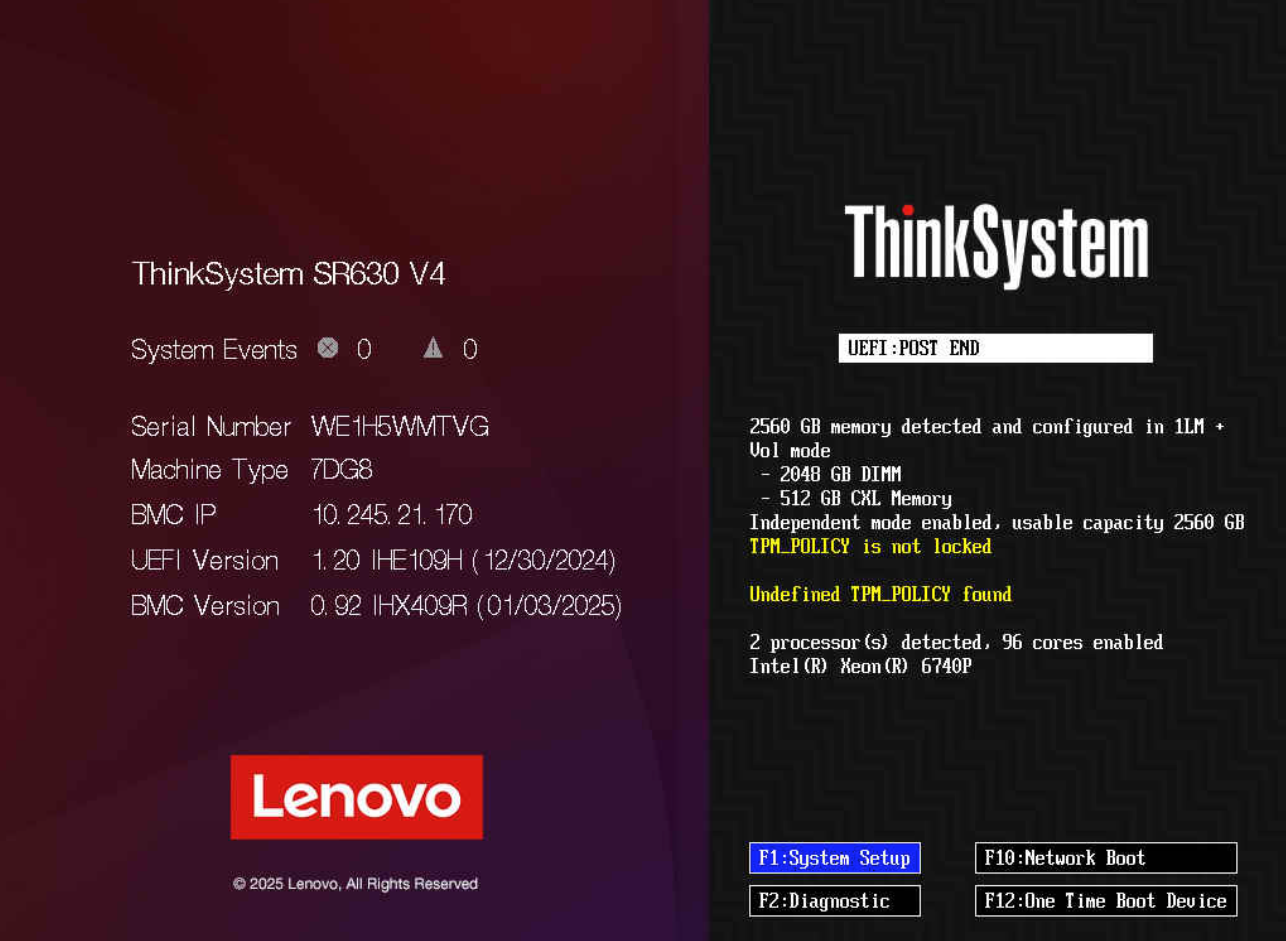
Figure 11. ThinkSystem SR630 V4 server boot to enter System Setup - Select System Settings > Memory > CXL Memory Module > Memory Mode, and press Enter to select 1LM+Vol mode.
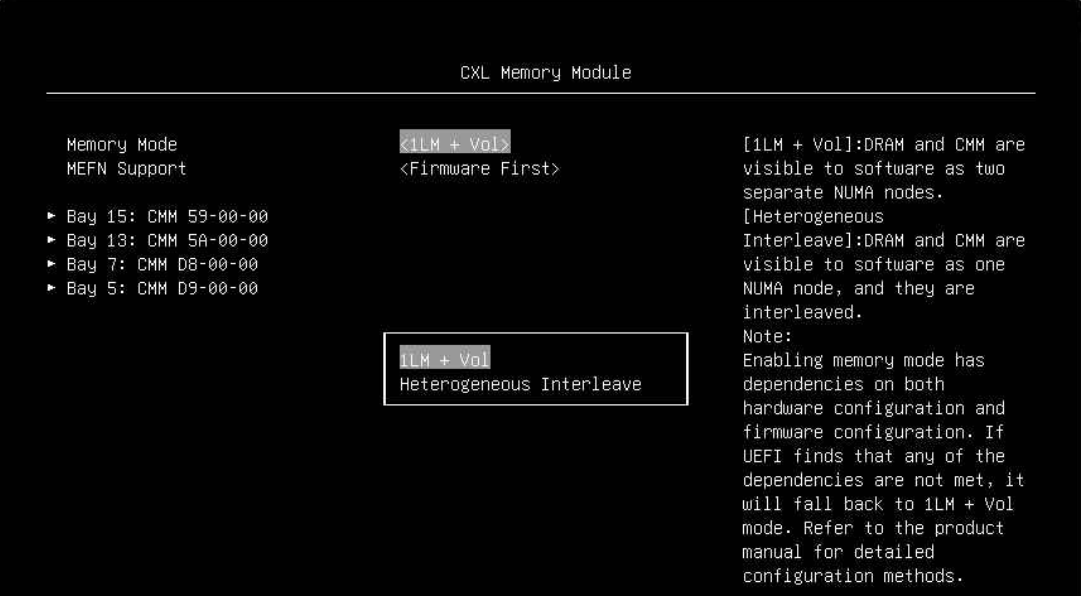
Figure 12. Select the CXL Memory Module’s Memory Mode to 1LM+Vol - Save the settings and reboot the system.
- After the system reboots to UEFI screen, the CXL operation mode should be in 1LM+Vol mode and the CXL memory capacity should be correctly detected, as shown in the right part of Figure 11.
- Install the Ubuntu 24.04 LTS server version OS with HWE kernel. It should be straight forward, and we will not describe the OS installation details here. For more details on the Ubuntu server OS, see https://ubuntu.com/server

Figure 14. Install the Ubuntu 24.04 LTS server version OS with HWE kernel - Now, boot to OS for CXL memory module validation.
CXL memory validation
In this section, we will verify the proper CXL memory module functionality in the Linux OS for this system, by checking the command output correctness with Linux commands like lspci, dmesg, free, lsmod, numactl, … etc., then we will use CXL related command line interface (CLI) tools to confirm CXL memory modules are running in the expected mode: 1LM+Vol mode.
Linux commands
Below is a list of Linux OS built-in commands required to check the CXL components in the server from the OS perspective. Use these to get an overall picture about how the Linux OS CXL subsystem sees the CXL components and their behaviors.
- lspci -vvv
One CXL memory device is detected at 0000:59:00.0 and similar devices are also detected at 0000:5a:00.0, 0000:d8:00.0, and 0000:d9:00.0 (not listed here). Note that NUMA node information from this command is not accurate; it should be NUMA node 2 and 3, as in the ACPI SRAT table, and the numactl command output (see below).
lspci -vvv 0000:59:00.0 CXL: Montage Technology Co., Ltd. Device c002 (rev 03) (prog-if 10 [CXL Memory Device (CXL 2.x)]) Subsystem: Samsung Electronics Co Ltd Device 0112 Physical Slot: 79 Control: I/O- Mem+ BusMaster+ SpecCycle- MemWINV- VGASnoop- ParErr+ Stepping- SERR+ FastB2B- DisINTx+ Status: Cap+ 66MHz- UDF- FastB2B- ParErr- DEVSEL=fast >TAbort- SERR- Kernel driver in use: cxl_pci Kernel modules: cxl_pci - dmesg | grep ACPI | grep SRAT
With this command, we confirm that this system’s UEFI correctly implements the SRAT (System Resource Affinity Table) necessary for the CXL devices to be seen and interacted with the OS. Now the hotplug memory devices (CXL memory modules) are arranged as NUMA node 2 and 3. Note that the memory ranges are also compatible with the output from the command: cxl list -Hu (see the cxl list -Hu command in the CXL related commands section)
dmesg | grep ACPI | grep SRAT [ 0.010743] ACPI: SRAT: Node 0 PXM 0 [mem 0x00000000-0x7fffffff] [ 0.010745] ACPI: SRAT: Node 0 PXM 0 [mem 0x100000000-0x1007fffffff] [ 0.010746] ACPI: SRAT: Node 1 PXM 1 [mem 0x67e80000000-0x77e7fffffff] [ 0.010749] ACPI: SRAT: Node 2 PXM 10 [mem 0x10080000000-0x1407fffffff] hotplug [ 0.010750] ACPI: SRAT: Node 3 PXM 11 [mem 0x77e80000000-0x7be7fffffff] hotplug - free
The command show that the total memory space available to the OS is 2.5 TB, which is expected when all CXL memory module memory space is activated and available to the OS.
free total used free shared buff/cache available Mem: 2650416280 21271888 2636001748 13164 1013908 2629144392 Swap: 8388604 0 8388604 - lsmod | grep -i CXL
This command lists all the CXL memory device related kernel modules that are loaded.
lsmod | grep -i CXL dax_cxl 12288 0 cxl_mem 12288 0 cxl_pmu 32768 0 cxl_pmem 24576 0 cxl_port 16384 0 cxl_pci 28672 0 cxl_acpi 24576 0 cxl_core 299008 11 cxl_pmem,cxl_port,cxl_mem,cxl_pci,dax_cxl,cxl_acpi,cxl_pmu - numactl -H
This command shows that there are 4x NUMA nodes. The DRAM memory spaces are arranged as NUMA node 0 and 1, each with size 1.0 TB, while CXL memory module memory spaces are arranged as NUMA node 2 and 3, each with size 256 GB.
numactl -H available: 4 nodes (0-3) node 0 cpus: 0 1 2 3 4 5 6 7 8 9 10 11 12 13 14 15 16 17 18 19 20 21 22 23 24 25 26 27 28 29 30 31 32 33 34 35 36 37 38 39 40 41 42 43 44 45 46 47 96 97 98 99 100 101 102 103 104 105 106 107 108 109 110 111 112 113 114 115 116 117 118 119 120 121 122 123 124 125 126 127 128 129 130 131 132 133 134 135 136 137 138 139 140 141 142 143 node 0 size: 1031904 MB node 0 free: 1025554 MB node 1 cpus: 48 49 50 51 52 53 54 55 56 57 58 59 60 61 62 63 64 65 66 67 68 69 70 71 72 73 74 75 76 77 78 79 80 81 82 83 84 85 86 87 88 89 90 91 92 93 94 95 144 145 146 147 148 149 150 151 152 153 154 155 156 157 158 159 160 161 162 163 164 165 166 167 168 169 170 171 172 173 174 175 176 177 178 179 180 181 182 183 184 185 186 187 188 189 190 191 node 1 size: 1032105 MB node 1 free: 1024244 MB node 2 cpus: node 2 size: 262144 MB node 2 free: 262143 MB node 3 cpus: node 3 size: 262144 MB node 3 free: 262142 MB node distances: node 0 1 2 3 0: 10 21 14 24 1: 21 10 24 14 2: 14 24 10 26 3: 24 14 26 10
CXL related commands
As mentioned in Table 2 and Figure 7 in the CXL device support: Software perspective section, all the NDCTL, DAXCTL, and CXL-CLI packages are required for validation of CXL memory module operation modes. Some of the OS either did not have these packages, or they shipped with older versions of these packages, in such case, you may need to install or upgrade to the latest versions of these software packages to make sure they work properly on your OS.
To install the NDCTL and DAXCTL packages on Linux, please follow the steps listed in:
https://docs.pmem.io/ndctl-user-guide/installing-ndctl/installing-ndctl-packages-on-linux
To install the CXL-CLI package on Linux, please follow the steps listed in:
https://docs.pmem.io/ndctl-user-guide/installing-ndctl/installing-the-cxl-cli-package-on-linux
After installing or upgrading the necessary software packages, we can perform the commands with results shown below.
- daxctl list -Mu
The output indicates that there are two dax devices, dax0.0 and dax9.0, assigned to NUMA node 2 and 3 respectively, each with size 256 GB and both are running in the system-ram mode.
daxctl list -Mu [ { "chardev":"dax9.0", "size":"256.00 GiB (274.88 GB)", "target_node":3, "align":2097152, "mode":"system-ram" }, { "chardev":"dax0.0", "size":"256.00 GiB (274.88 GB)", "target_node":2, "align":2097152, "mode":"system-ram" } ] - cxl list -Hu
This command indicates that there are 4x CXL memory devices, mem0 to mem3, each with a size 128 GB. These devices are grouped into two regions, region0 and region9, and both regions are running in the ram type mode. This is compatible with the information from the daxctl command, which is the expected result.
Note that in this case, the CXL command output says some misleading information about the NUMA node 0 and 1, while both daxctl and numactl command outputs say the CXL NUMA nodes are 2 and 3. We remind users about this difference to take care of, if the exact NUMA node numbers are important in the user application. We expect the future version of OS and CXL CLI will correct this issue.
cxl list -Hu [ { "memdevs":[ { "memdev":"mem0", "ram_size":"128.00 GiB (137.44 GB)", "serial":"0x7fffffffffffffff", "numa_node":0, "host":"0000:59:00.0" }, { "memdev":"mem1", "ram_size":"128.00 GiB (137.44 GB)", "serial":"0x7fffffffffffffff", "numa_node":0, "host":"0000:5a:00.0" }, { "memdev":"mem3", "ram_size":"128.00 GiB (137.44 GB)", "serial":"0x7fffffffffffffff", "numa_node":1, "host":"0000:d9:00.0" }, { "memdev":"mem2", "ram_size":"128.00 GiB (137.44 GB)", "serial":"0x7fffffffffffffff", "numa_node":1, "host":"0000:d8:00.0" } ] }, { "regions":[ { "region":"region0", "resource":"0x10080000000", "size":"256.00 GiB (274.88 GB)", "type":"ram", "interleave_ways":2, "interleave_granularity":256, "decode_state":"commit" }, { "region":"region9", "resource":"0x77e80000000", "size":"256.00 GiB (274.88 GB)", "type":"ram", "interleave_ways":2, "interleave_granularity":256, "decode_state":"commit" } ] } ]
As shown with the above command outputs, we validated that the CXL memory modules behave correctly with both Linux commands, and CXL CLI-related commands with Ubuntu 24.04 LTS OS, on the Lenovo ThinkSystem SR630 V4 server system.
Known issues and troubleshooting
In addition to the above mentioned lspci and CXL CLI NUMA node information issue with Ubuntu 24.04, the issues below were also found in recent Linux OS distributions. Lenovo is working with the OS vendors and expecting these issues will be fixed in the future releases.
- CXL related complaining messages shown even CXL-capable PCIe root port did not attach CXL device (on Ubuntu 24.04, RHEL 9.5)
- Not able to run the CMM (CXL Memory Module) in the 1LM+Vol mode under SLES15.6
- CXL CLI tool does not work correctly with CXL device under RHEL9.4
References
For more information, see these references:
- CXL 2.0 and 3.0 specifications:
https://computeexpresslink.org/wp-content/uploads/2024/02/CXL-2.0-Specification.pdf
https://computeexpresslink.org/wp-content/uploads/2024/02/CXL-3.0-Specification.pdf - CXL + Memory Expander - Baseline Guide for Birch Stream (login required)
https://www.intel.com/content/www/us/en/secure/content-details/803836/cxl-memory-expander-baseline-guide-for-birch-stream.html?wapkw=803836 - CXL Type 3 Memory Device Software Guide
https://www.intel.com/content/www/us/en/content-details/643805/cxl-memory-device-software-guide.html?wapkw=643805 - CXL Supplemental Validation Guide – Birch Stream (login required)
https://www.intel.com/content/www/us/en/secure/content-details/814339/compute-express-link-cxl-supplemental-validation-guide-for-birch-stream.html?wapkw=814339 - Installing the CXL-CLI Package on Linux
https://docs.pmem.io/ndctl-user-guide/installing-ndctl/installing-the-cxl-cli-package-on-linux - A Practical Guide to Identify Compute Express Link (CXL) Devices in Your Server
https://stevescargall.com/blog/2023/05/a-practical-guide-to-identify-compute-express-link-cxl-devices-in-your-server/ - Using Linux Kernel Tiering with Compute Express Link (CXL) Memory
https://stevescargall.com/blog/2024/05/using-linux-kernel-tiering-with-compute-express-link-cxl-memory/ - Memory Hot(Un)Plug
https://docs.kernel.org/admin-guide/mm/memory-hotplug.html
Author
Kelvin Shieh is the OS Development Technical Lead for the Lenovo Infrastructure Solutions Group, based in Taipei, Taiwan.
Trademarks
Lenovo and the Lenovo logo are trademarks or registered trademarks of Lenovo in the United States, other countries, or both. A current list of Lenovo trademarks is available on the Web at https://www.lenovo.com/us/en/legal/copytrade/.
The following terms are trademarks of Lenovo in the United States, other countries, or both:
Lenovo®
ThinkSystem®
The following terms are trademarks of other companies:
Intel®, the Intel logo and Xeon® are trademarks of Intel Corporation or its subsidiaries.
Linux® is the trademark of Linus Torvalds in the U.S. and other countries.
Windows® is a trademark of Microsoft Corporation in the United States, other countries, or both.
Other company, product, or service names may be trademarks or service marks of others.
Configure and Buy
Full Change History
Course Detail
Employees Only Content
The content in this document with a is only visible to employees who are logged in. Logon using your Lenovo ITcode and password via Lenovo single-signon (SSO).
The author of the document has determined that this content is classified as Lenovo Internal and should not be normally be made available to people who are not employees or contractors. This includes partners, customers, and competitors. The reasons may vary and you should reach out to the authors of the document for clarification, if needed. Be cautious about sharing this content with others as it may contain sensitive information.
Any visitor to the Lenovo Press web site who is not logged on will not be able to see this employee-only content. This content is excluded from search engine indexes and will not appear in any search results.
For all users, including logged-in employees, this employee-only content does not appear in the PDF version of this document.
This functionality is cookie based. The web site will normally remember your login state between browser sessions, however, if you clear cookies at the end of a session or work in an Incognito/Private browser window, then you will need to log in each time.
If you have any questions about this feature of the Lenovo Press web, please email David Watts at dwatts@lenovo.com.

